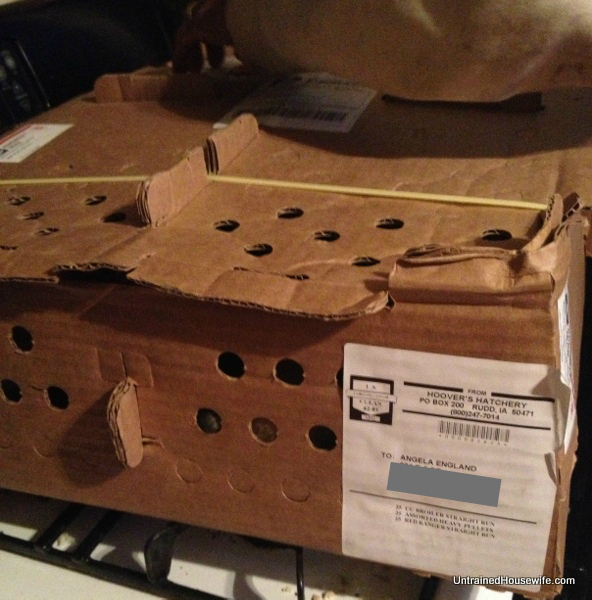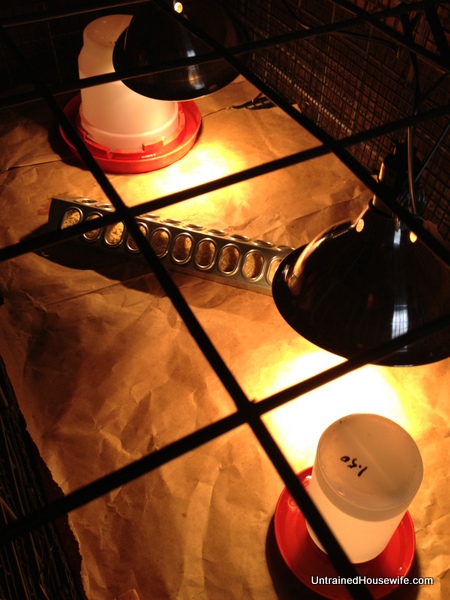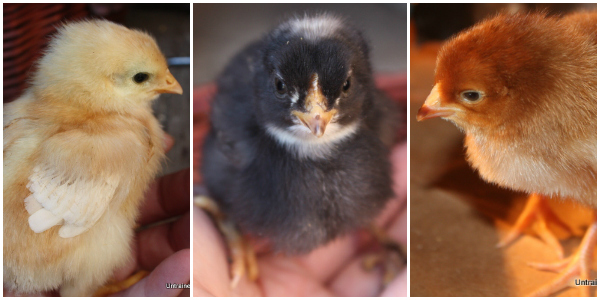When we first started keeping chickens we usually stopped by a local feed store and picked up a handful of baby chicks from the cheeping-fluff-filled cages in the back corner. It didn’t take us long to try ordering baby chicks mail-order instead. Wow! What a difference! Half the price and a simple phone call – nothing could be easier. Wondering how it works?
You call Hoover’s Hatchery (We’ve used a couple different places now and never received such fabulous birds for such reasonable prices as we do with Hoover’s Hatchery) and tell them which birds you want. They tell you when they will ship and on the day of arrival the post office calls you to let you know they’ve arrived.
The Chicks Arrive Packed Nice and Neat

Originally published March 2013, updated below March 2014. The chicks come in cardboard packing crates and there’s a reason why most mail order companies suggest a 25 chick minimum – the warmth of the other chicks helps to keep everyone happy and alive during shipping. We ordered 25 Cornish Cross, 25 Red Rangers (a different strain of hybrid meat birds), and 25 mixed layers and they all came in one box. Hoover’s Hatchery included 4 extra birds which is always nice in case any die during the shipping process.

Meat chicks on the left and mixed layers on the right.
Be Ready to Unpack Your Chicks Quickly
When your chicks arrive they’ve been out of their eggs from 24 hours, or a little longer, and are hungry and thirsty. You should have your brood cage set up and ready to go. This is a good example of a brood area for a large number of chicks – heat lamps at even intervals, large feeder to allow plenty of access to food, and more than one water dish (if you only have a handful of chicks you are fine with one). Fresh water is a must for chickens!

Brood cage set up for baby chicks.
How Did Our Chicks Look?
See for yourself! They can happy, active, and not a single dead one in the bunch! They started eating and drinking immediately but it’s important that when your chicks arrive you watch them carefully to make sure they find their water. Sometimes you may need to dip the chick’s beak into the water dish so they know where the fresh water is.
Keeping Chicks Warm in the Brood Cage
Most people heat their brood cage with simple heat lamps hung over the top of the cage. Watch out! These ARE HOT and can cause a fire if they fall against something combustible (include plastic watering dishes, wood shaving bedding, or cardboard sides). If you have a larger cage like ours, you may need to start out with two heat lamps.

You can tell the temperature is good in the cage because the chicks are spread out and about doing different things. If the chicks are pushed way out to the far edges away from the heater, or panting with beaks open, it is too hot and you should lower the temperature. If the chicks are huddled pitifully side-by-side directly under the light, it’s too cold and you should increase the temperature. Chicks like these are happy, have everything they need, and are in a good temperature range.
These chicks were sent to us by Hoover’s Hatchery so we could provide an accurate review of the ordering and shipping process. These photos are our personal experience and actual chicks received. March 2014 Update – the chicks did very well and most of them survived the full year. All the hens started laying by Fall and have continued to be happy and healthy chicks for us.








Aw, they are so sweet, and you got a nice variety! I’ll be interested in seeing more photos of them as they grow up!
~Kristi@Let This Mind Be in You
Those chicks look great! We’ve never tried Hoovers. Actually, we haven’t ordered any birds for a long time, as we’ve become incubators ourselves. But every now and then it’s a good idea to bring in new blood (we think), so we will give Hoovers a look when the time comes.
In our brooder, which is made of OSB and is 4’X4′ square (we hatch over 100 at a time), we use a full bag of compressed pine shavings for the bottom. We were told years ago that the pine had unique “sanitizing” properties, and our experience seems to bear that out. We don’t have to change it out until the chicks are ready to be moved. Rather, from time to time, we take a 4-pronged garden rake (there’s a name for that tool that escapes me at the moment), and stir it completely. So far, so good.
Great post, thanks for sharing this experience!
Ahh!! I’m trying to convince Jon that we need some chickens, even if for no other reason than for the 8 eggs a month I use. ‘;-)